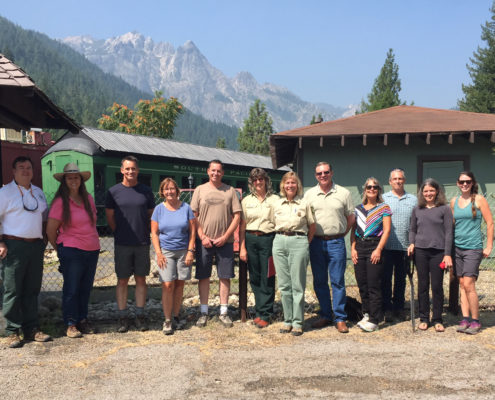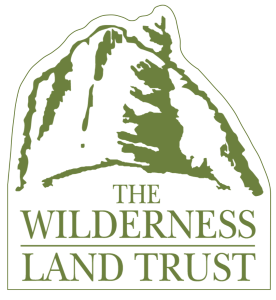A Unique Partnership
for Castle Crags
“When I learned of their work to protect Castle Crags, I looked them up online and cold called them, asking how I could help.”
-Dr. Grover Shipman
On a cool August evening, Dr. Grover Shipman stood on a cliff and gazed across the majestic Castle Crags skyline. The California ER physician lives a short 20 minute drive from the Castle Crags Wilderness area and the view of the saw-toothed ridge, which stretches from Castle Dome all the way to Castle Lake, is a familiar one. But on this day, the view held new meaning for him. That morning he’d stood witness  to a small ribbon cutting ceremony on the north side of Castle Crags. The ceremony was brief and lacked much fanfare, but for the small group in attendance, the ceremony marked a unique alliance between a land trust, three timber companies, the climbing community and the Forest Service. It also represented the culmination of five years of hard work to protect and preserve 1257 acres of land adjacent to the Castle Crags Wilderness, and provide a positive economic impact for local communities through additional public recreation access.
to a small ribbon cutting ceremony on the north side of Castle Crags. The ceremony was brief and lacked much fanfare, but for the small group in attendance, the ceremony marked a unique alliance between a land trust, three timber companies, the climbing community and the Forest Service. It also represented the culmination of five years of hard work to protect and preserve 1257 acres of land adjacent to the Castle Crags Wilderness, and provide a positive economic impact for local communities through additional public recreation access.
“I first became aware of The Wilderness Land Trust in 2013,” says Grover. “They were responsible for protecting more than 30,000 acres in 55 wilderness areas just in California. When I learned of their work to protect Castle Crags, I looked them up online and cold called them, asking how I could help.”
Why Castle Crags? “I’m an avid rock climber and a member of the Access Fund, a not-for-profit advocacy group that works to preserve the access to rock climbing areas in the U.S. and balance recreational use with resource conservation,” says Grover. “So I contacted Access Fund and said this land purchase by The Wilderness Land Trust was worth backing and could preserve climbing access in the area.”
“I had a chance to climb at Castle Crags with Grover three years ago,” says Joe Sambataro, National Access Director at Access Fund. “It’s a unique experience to visit a wild, backcountry place like Castle Crags, given it’s just a short drive off the interstate. Within 30 minutes, you are surrounded by forest, spires, and ridgelines that continue for miles on end. Acquisitions like this are about conservation and recreation. Most importantly, they ensure a future of outdoor experiences for all who visit.”
More than world-class climbing, Castle Crags is home to eagles and other raptors, and in the forest, almost 1,000 acres of mature timber now stand protected. Little Castle Creek also provides spawning habitat for trout and fishing opportunities, and it flows to the Sacramento River, providing clean water throughout California via the Sacramento River Delta. Threatened species like the spotted bat and the Castle Crags harebell, as well as Bald Eagles, black bear, martens, fishers and the northern spotted owl rely on the Crags for their habitat.
Numerous organizations and community members stepped forward to write letters of support for this land purchase, including the Wintu Tribe of Northern California & Toyon Wintu Center. In a moving letter to the Shasta-Trinity National Forest supervisor, Tribal Chairman Wade A. McMaster wrote, “This land is very sacred to our people; our ancestors once died in battle in this place to protect the land. Currently members of our Tribe return to this land to gather medicine and seek spiritual healing and guidance. There are rare species of plants and animals in this place that are important to our people and to all people in general. There are headwaters to three major basins in California and it is the source of clean water.”
“Our American heritage includes having these wild and free lands where people can explore and bear witness to the natural world. This is something we can pass on to future generations. We can be good stewards of this land,” adds Grover.
—————–
About the Castle Crags Purchase
Two square miles of land adjacent to the Castle Crags State Park and Federal Wilderness were acquired by the Wilderness Land Trust by sale from Roseburg Forest Products. As a result of the acquisition, more than 1,250 acres will be eventually transferred to the USDA-Forest Service for inclusion in the Shasta-Trinity National Forest. Funding for the transaction was provided by the David and Lucile Packard Foundation, along with the Access Fund Climbing Conservation Loan Program and The Conservation Alliance. This land purchase has resulted in permanent protection of the beloved Castle Crags area in northern California, a rock climbing destination and an important water source for the citizens of California.


